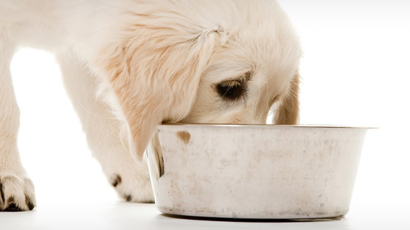Importance of a Good Diet for Puppy Nutrition

Feeding your puppy the right nutrition is vital for a great start in life.
One of the most important questions I ask brand new puppy parents is “What are you currently feeding your puppy?”. If it’s Black Hawk Puppy food, then I am confident that the puppy is receiving a complete and balanced diet.
Why does a puppy food need to be balanced for growth?
It is vital to ensure that growing puppies receive a complete and balanced diet. Puppies have an incredibly high exponential growth rate – ranging from 13% per week for toy breeds to 17% per week for giant breeds1. So, there is no room for error when making important diet decisions for your puppy.
It doesn’t have to be complicated – if you use a diet that is well-balanced for growth, such as the Black Hawk Puppy range, then you do not need to add anything else as the hard work of getting the ingredients right has already been done for you. Growing dogs should not receive vitamin or mineral supplements when fed complete, balanced high-quality commercial foods.
If a puppy is fed a diet that is not matched to their nutritional requirements, then can permanently affect development. This can occur when well-meaning pet owners try to formulate their own home-prepared puppy diets2.
Calcium: phosphorus ratio
The best puppy diet contains the correct calcium:phosphorus ratio, which is vital for musculoskeletal development.
For small and medium puppy breeds, the recommended ratio is 1.1-2:13 (Black Hawk Puppy dry food is 1.8, which is perfect).
For large and giant puppy breeds, the ratio needs to be within a much narrower range of between 1.1-1.54 due to the risk of orthopaedic abnormalities if calcium is either deficient or excessive. Black Hawk Puppy Large Breed has the nutritional balance perfect with the calcium:phosphorus ratio at 1.5.
A ratio that is too high can lead to cartilage abnormalities such as some forms of elbow dysplasia e.g. osteochondrosis dissecans (OCD), which may require surgical intervention later.
A ratio that is too low can lead to abnormal bowing of limbs and even pathological fractures of bones due to a lack of calcium laid down in the bone.
Caloric intake
It’s important not to overfeed your puppy as having excess weight can contribute to musculoskeletal abnormalities, such as hip dysplasia, during the growth phase. Black Hawk’s puppy range has a feeding guide to help avoid overweight pups. Your veterinarian will assess your puppy’s body condition score during each clinical exam and advise you whether the diet is adequate or excessive in calories.
Three key points to consider when choosing the best puppy food
-

Choose high nutrient density over high volume
Premium puppy foods, such as Black Hawk, require less food to be fed compared to cheaper lower quality varieties, because there is a higher nutrient density – feeding more is not necessarily better. It’s the quality that counts. So when budgeting for the best puppy food, first look at the amount in grams that needs to be fed to meet your puppy’s nutritional requirements, rather than the cost per gram comparison.
-

Avoid foods claiming to be appropriate for all life stages
Dog food diets claiming to be suitable for both puppies and adults are risky because the nutritional requirements for puppies averaging 15% exponential growth rate per week is very different to an adult dog.
-

Choose a puppy food that has a large breed specific puppy food line
Large and giant breed puppies such as Labradors and Great Danes need food that is formulated differently to avoid orthopaedic abnormalities and malformations, which can occur if the dietary calcium or protein content is too low or too high. (Ref. 5, 6)
References:
1. Peterson ME, Kutzler M. Small Animal Pediatrics: The First 12 Months of Life. 2011. Elsevier.
2. Streiff EL, Zwischenberger B, Butterwick RF, Wagner E, Iben C, Bauer JE. A comparison of the nutritional adequacy of home-prepared and commercial diets for dogs. J Nutr. 2002;132:1698S-700S.
3. Association of American Feed Control Officials (AAFCO Guildelines) www.aafco.org
4. Hand M, Thatcher CD, Remillard R, Roudebush P, Novotny B. Small Animal Clinical Nutrition. 2010. Mark Morris Institute.
5. Tryfonidou MA, Holl MS, Vastenburg M, Oosterlaken-Dljksterhuis MA, Birkenhager-Frenkel DH, van den Brom WE, Hazewinkel HA. Hormonal regulation of calcium homeostasis in two breeds of dogs during growth at different rates. J Anim Sci. 2003;81(6):1568-80.
6. Larsen J. Focus on nutrition: feeding large breed puppies. Compend Contin Educ Vet. 2010;32(5):E1-4.



